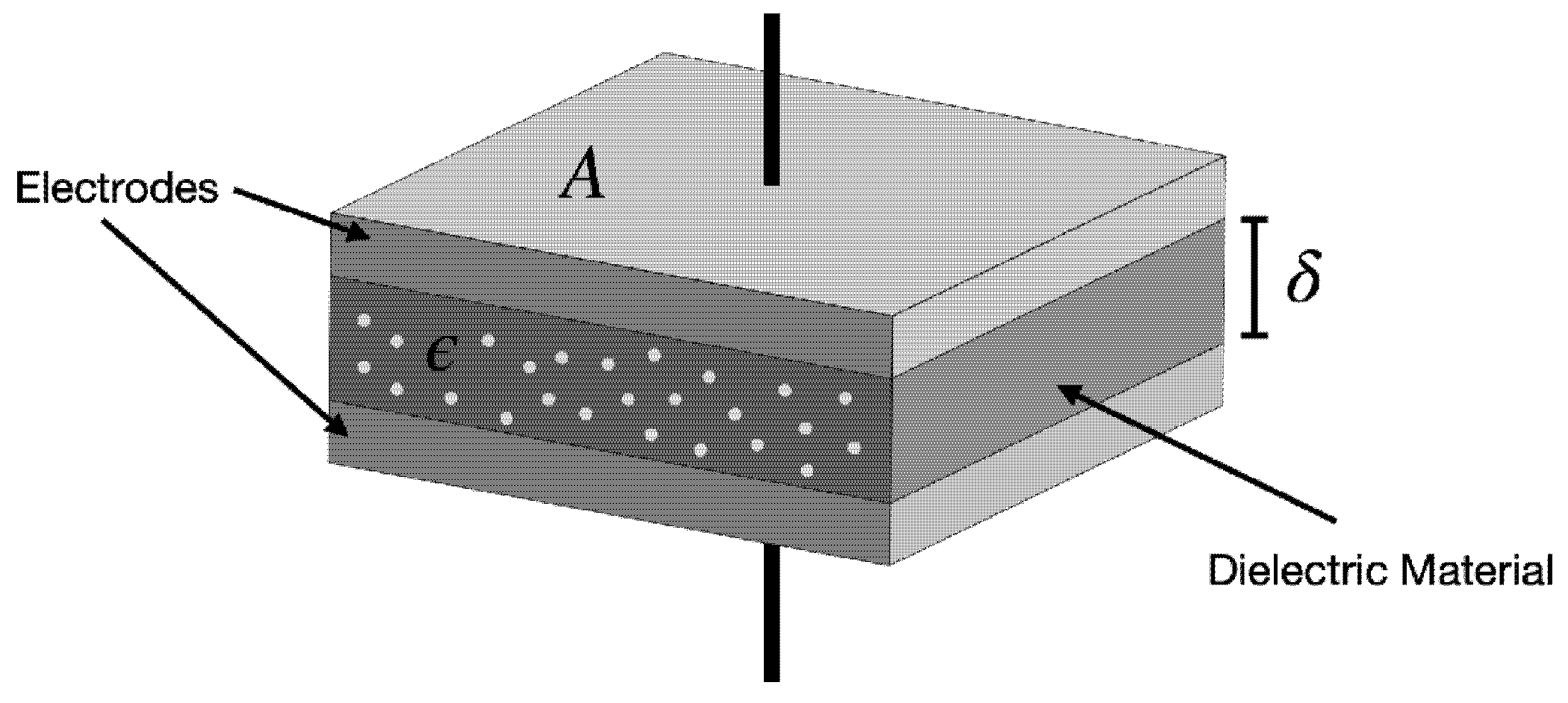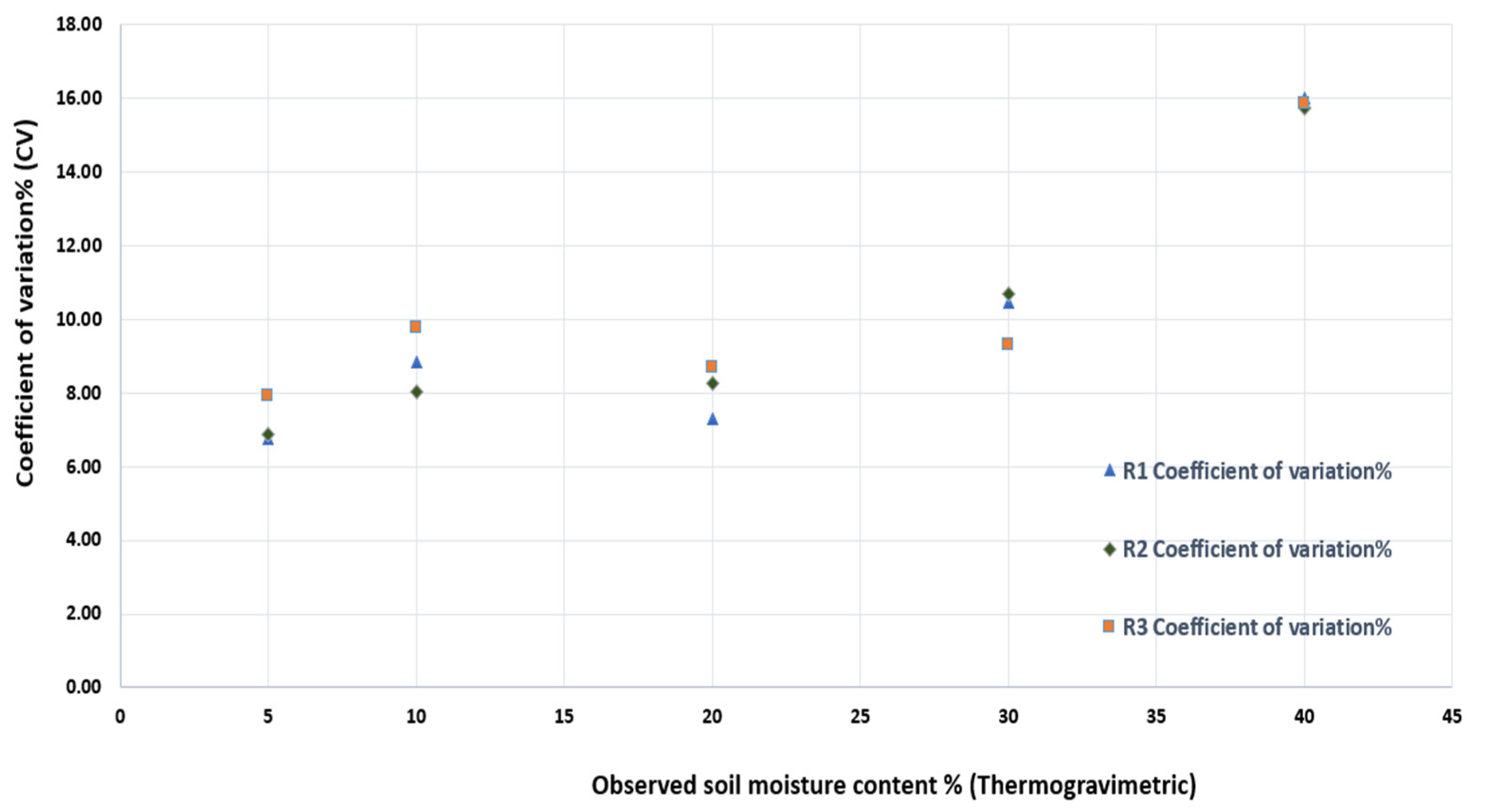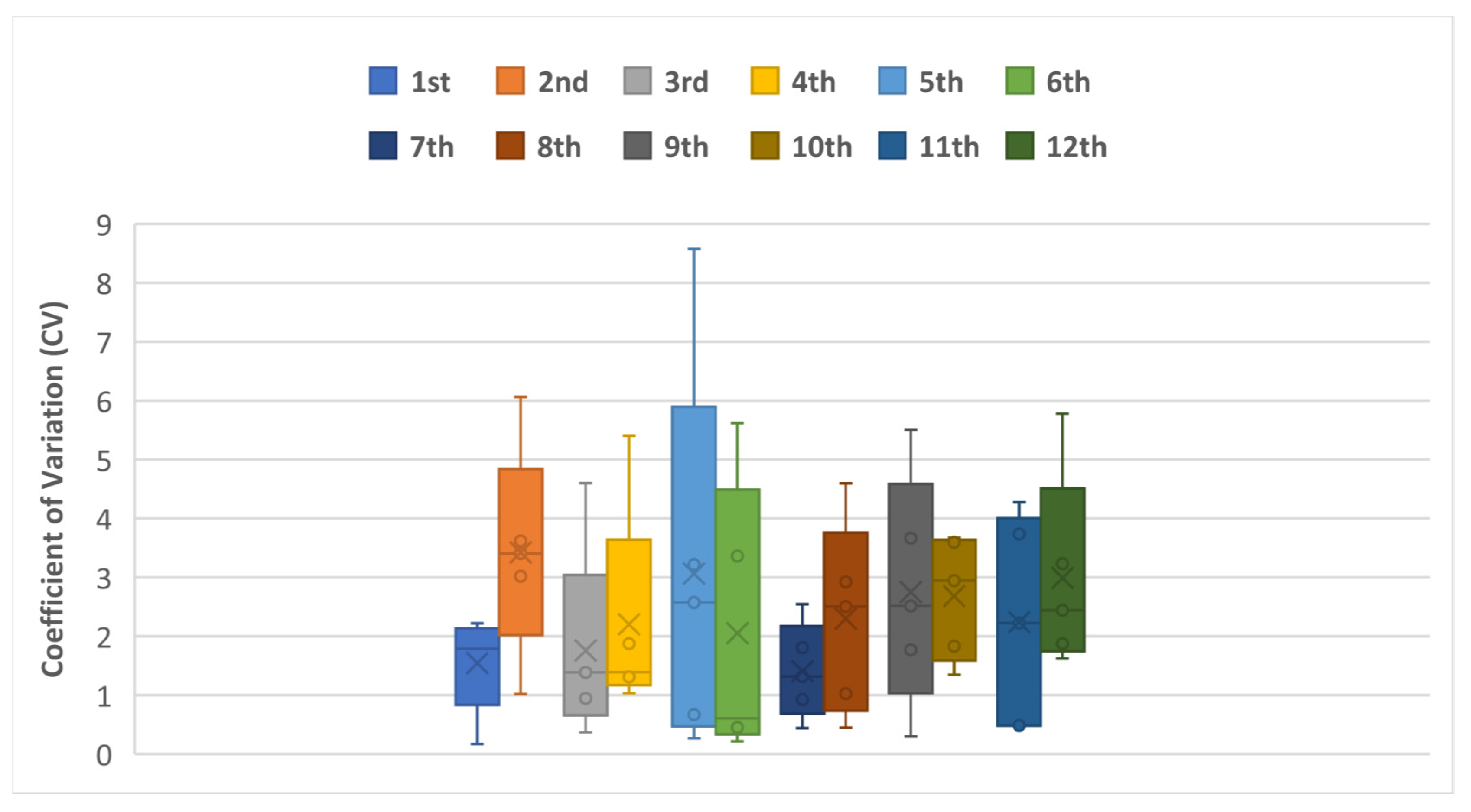Calibration of Low-Cost Capacitive Soil Moisture Sensors for Irrigation Management Applications
Abstract
1. Introduction
- SKU:SEN0193 is a cost-effective sensor commonly used and distinguished by its practicality to integrate in IoT solutions,
- However, it necessitates careful calibration with local conditions to be able to generate reliable results and to be integrated with smart farming systems.
2. Materials and Methods
2.1. Capacitive Soil Moisture Sensors
2.2. Soil Sampling and the Calibration Process
3. Results and Discussion
3.1. Sensor Calibration Equation
3.2. Sensor Accuracy
3.3. Sensor Variability and the Coefficient of Variation
4. Conclusions
Author Contributions
Funding
Informed Consent Statement
Data Availability Statement
Conflicts of Interest
References
- Mishra, R.K. Fresh water availability and its global challenge. Br. J. Multidiscip. Adv. Stud. 2023, 4, 1–78. [Google Scholar] [CrossRef]
- McDermid, S.; Nocco, M.; Lawston-Parker, P.; Keune, J.; Pokhrel, Y.; Jain, M.; Jägermeyr, J.; Brocca, L.; Massari, C.; Jones, A.D. Irrigation in the Earth system. Nat. Rev. Earth Environ. 2023, 4, 435–453. [Google Scholar] [CrossRef]
- Hardie, M. Review of novel and emerging proximal soil moisture sensors for use in agriculture. Sensors 2020, 20, 6934. [Google Scholar] [CrossRef] [PubMed]
- Abdelmoneim, A.A.; Khadra, R.; Derardja, B.; Dragonetti, G. Internet of Things (IoT) for Soil Moisture Tensiometer Automation. Micromachines 2023, 14, 263. [Google Scholar] [CrossRef] [PubMed]
- Chartzoulakis, K.; Bertaki, M. Sustainable water management in agriculture under climate change. Agric. Agric. Sci. Procedia 2015, 4, 88–98. [Google Scholar] [CrossRef]
- Fereres, E.; Soriano, M.A. Deficit irrigation for reducing agricultural water use. J. Exp. Bot. 2007, 58, 147–159. [Google Scholar] [CrossRef] [PubMed]
- Abdelmoneim, A.A.; Daccache, A.; Khadra, R.; Bhanot, M.; Dragonetti, G. Internet of Things (IoT) for double ring infiltrometer automation. Comput. Electron. Agric. 2021, 188, 106324. [Google Scholar] [CrossRef]
- Campbell, G.S. Soil water potential measurement: An overview. Irrig. Sci. 1988, 9, 265–273. [Google Scholar] [CrossRef]
- Bianchi, A.; Masseroni, D.; Thalheimer, M.; Medici, L.; Facchi, A. Field irrigation management through soil water potential measurements: A review. Ital. J. Agrometeorol. 2017, 22, 25–38. [Google Scholar]
- Abdelmoneim, A.A.; Khadra, R.; Elkamouh, A.; Derardja, B.; Dragonetti, G. Towards Affordable Precision Irrigation: An Experimental Comparison of Weather-Based and Soil Water Potential-Based Irrigation Using Low-Cost IoT-Tensiometers on Drip Irrigated Lettuce. Sustainability 2023, 16, 306. [Google Scholar] [CrossRef]
- Chowdhury, S.; Sen, S.; Janardhanan, S. Comparative analysis and calibration of low cost resistive and capacitive soil moisture sensor. arXiv 2022, arXiv:2210.03019. [Google Scholar]
- Kitić, G.; Crnojević-Bengin, V. A sensor for the measurement of the moisture of undisturbed soil samples. Sensors 2013, 13, 1692–1705. [Google Scholar] [CrossRef] [PubMed]
- Raghunath, S.; Devi, K.S. IOT in precision farming for a sustainable future. J. Pharm. Negat. Results 2022, 13, 728–736. [Google Scholar]
- Adla, S.; Rai, N.K.; Karumanchi, S.H.; Tripathi, S.; Disse, M.; Pande, S. Laboratory calibration and performance evaluation of low-cost capacitive and very low-cost resistive soil moisture sensors. Sensors 2020, 20, 363. [Google Scholar] [CrossRef]
- Walker, J.P.; Willgoose, G.R.; Kalma, J.D. In situ measurement of soil moisture: A comparison of techniques. J. Hydrol. 2004, 293, 85–99. [Google Scholar] [CrossRef]
- de los Ángeles Calva Jiménez, A.; Duarte Guedes Cabral de Almeida, C.; Santos Júnior, J.A.d.; Silva dos Santos, C. Calibration of two capacitive soil moisture sensors in Ultisol. Dyna 2020, 87, 75–79. [Google Scholar]
- Mukhlisin, M.; Astuti, H.W.; Wardihani, E.D.; Matlan, S.J. Techniques for ground-based soil moisture measurement: A detailed overview. Arab. J. Geosci. 2021, 14, 1–34. [Google Scholar] [CrossRef]
- Sakaki, T.; Limsuwat, A.; Illangasekare, T.H. A Simple Method for Calibrating Dielectric Soil Moisture Sensors: Laboratory Validation in SandsAll rights reserved. No part of this periodical may be reproduced or transmitted in any form or by any means, electronic or mechanical, including photocopying, recording, or any information storage and retrieval system, without permission in writing from the publisher. Vadose Zone J. 2011, 10, 526–531. [Google Scholar]
- Cardenas-Lailhacar, B.; Dukes, M.D. Precision of soil moisture sensor irrigation controllers under field conditions. Agric. Water Manag. 2010, 97, 666–672. [Google Scholar] [CrossRef]
- Stacheder, M.; Koeniger, F.; Schuhmann, R. New dielectric sensors and sensing techniques for soil and snow moisture measurements. Sensors 2009, 9, 2951–2967. [Google Scholar] [CrossRef] [PubMed]
- Kulmány, I.M.; Bede-Fazekas, Á.; Beslin, A.; Giczi, Z.; Milics, G.; Kovács, B.; Kovács, M.; Ambrus, B.; Bede, L.; Vona, V. Calibration of an Arduino-based low-cost capacitive soil moisture sensor for smart agriculture. J. Hydrol. Hydromech. 2022, 70, 330–340. [Google Scholar] [CrossRef]
- Zazueta, F.S.; Xin, J. Soil moisture sensors. Soil Sci. 1994, 73, 391–401. [Google Scholar]
- Rao, B.H.; Singh, D. Moisture content determination by TDR and capacitance techniques: A comparative study. Int. J. Earth Sci. Eng. 2011, 4, 132–137. [Google Scholar]
- Selig, E.T.; Mansukhani, S. Relationship of soil moisture to the dielectric property. J. Geotech. Eng. Div. 1975, 101, 755–770. [Google Scholar] [CrossRef]
- Topp, G.; Davis, J. Measurement of soil water content using time-domain reflectrometry (TDR): A field evaluation. Soil Sci. Soc. Am. J. 1985, 49, 19–24. [Google Scholar] [CrossRef]
- Bogena, H.R.; Huisman, J.A.; Schilling, B.; Weuthen, A.; Vereecken, H. Effective calibration of low-cost soil water content sensors. Sensors 2017, 17, 208. [Google Scholar] [CrossRef] [PubMed]
- Vaz, C.M.; Jones, S.; Meding, M.; Tuller, M. Evaluation of standard calibration functions for eight electromagnetic soil moisture sensors. Vadose Zone J. 2013, 12, 1–16. [Google Scholar] [CrossRef]
- Pelletier, M.G.; Karthikeyan, S.; Green, T.R.; Schwartz, R.C.; Wanjura, J.D.; Holt, G.A. Soil moisture sensing via swept frequency based microwave sensors. Sensors 2012, 12, 753–767. [Google Scholar] [CrossRef] [PubMed]
- Visconti, F.; de Paz, J.M.; Martínez, D.; Molina, M.J. Laboratory and field assessment of the capacitance sensors Decagon 10HS and 5TE for estimating the water content of irrigated soils. Agric. Water Manag. 2014, 132, 111–119. [Google Scholar] [CrossRef]
- Zhang, R.-B.; Guo, J.-J.; Zhang, L.; Zhang, Y.-C.; Wang, L.-H.; Wang, Q. A calibration method of detecting soil water content based on the information-sharing in wireless sensor network. Comput. Electron. Agric. 2011, 76, 161–168. [Google Scholar] [CrossRef]
- Kojima, Y.; Shigeta, R.; Miyamoto, N.; Shirahama, Y.; Nishioka, K.; Mizoguchi, M.; Kawahara, Y. Low-cost soil moisture profile probe using thin-film capacitors and a capacitive touch sensor. Sensors 2016, 16, 1292. [Google Scholar] [CrossRef] [PubMed]
- Kodešová, R.; Kodeš, V.; Mraz, A. Comparison of two sensors ECH2O EC-5 and SM200 for measuring soil water content. Soil Water Res. 2011, 6, 102. [Google Scholar] [CrossRef]
- Ma, Y.; Qu, L.; Wang, W.; Yang, X.; Lei, T. Measuring soil water content through volume/mass replacement using a constant volume container. Geoderma 2016, 271, 42–49. [Google Scholar] [CrossRef]
- Placidi, P.; Gasperini, L.; Grassi, A.; Cecconi, M.; Scorzoni, A. Characterization of low-cost capacitive soil moisture sensors for IoT networks. Sensors 2020, 20, 3585. [Google Scholar] [CrossRef] [PubMed]
- Pereira, R.M.; Sandri, D.; Rios, G.F.A.; Sousa, D.A.d.O. Automation of irrigation by electronic tensiometry based on the arduino hardware platform. Rev. Ambiente Água 2020, 15, e2567. [Google Scholar] [CrossRef]
- Nagahage, E.A.A.D.; Nagahage, I.S.P.; Fujino, T. Calibration and validation of a low-cost capacitive moisture sensor to integrate the automated soil moisture monitoring system. Agriculture 2019, 9, 141. [Google Scholar] [CrossRef]
- Majumder, S.; Kasirao, G.; Himavarsha, P.; Chaudhary, S.; Sekopo, K.P.; Tanwar, T.; Verma, J. Assessing Low-cost Capacitive Soil Moisture Sensors: Accurate, Affordable, and IoT-ready Solutions for Soil Moisture Monitoring. Int. J. Environ. Clim. Chang. 2023, 13, 2233–2242. [Google Scholar] [CrossRef]
- Souza, G.; De Faria, B.T.; Alves, R.G.; Lima, F.; Aquino, P.T.; Soininen, J.-P. Calibration equation and field test of a capacitive soil moisture sensor. In Proceedings of the 2020 IEEE International Workshop on Metrology for Agriculture and Forestry (MetroAgriFor), Trento, Italy, 4–6 November 2020; pp. 180–184. [Google Scholar]
- Pereira, R.M.; Sandri, D.; da Silva Júnior, J.J. Evaluation of low-cost capacitive moisture sensors in three types of soils in the Cerrado, Brazil. Rev. Eng. Na Agric.-Reveng 2022, 30, 262–272. [Google Scholar] [CrossRef]
- Okasha, A.M.; Ibrahim, H.G.; Elmetwalli, A.H.; Khedher, K.M.; Yaseen, Z.M.; Elsayed, S. Designing low-cost capacitive-based soil moisture sensor and smart monitoring unit operated by solar cells for greenhouse irrigation management. Sensors 2021, 21, 5387. [Google Scholar] [CrossRef] [PubMed]
- Domínguez-Niño, J.M.; Oliver-Manera, J.; Arbat, G.; Girona, J.; Casadesús, J. Analysis of the variability in soil moisture measurements by capacitance sensors in a drip-irrigated orchard. Sensors 2020, 20, 5100. [Google Scholar] [CrossRef]
- Rende, A.; Biage, M. Characterization of capacitive sensors for measurements of the moisture in irrigated soils. J. Braz. Soc. Mech. Sci. 2002, 24, 226–233. [Google Scholar] [CrossRef]
- Fares, A.; Alva, A.K. Evaluation of capacitance probes for optimal irrigation of citrus through soil moisture monitoring in an entisol profile. Irrig. Sci. 2000, 19, 57–64. [Google Scholar] [CrossRef]
- Mander, G.; Arora, M. Design of capacitive sensor for monitoring moisture content of soil and analysis of analog voltage with variability in moisture. In Proceedings of the 2014 Recent Advances in Engineering and Computational Sciences (RAECS), Chandigarh, India, 6–8 March 2014; pp. 1–5. [Google Scholar]
- Fang, H.-Y.; Daniels, J.L. Introductory Geotechnical Engineering; CRC Press: Boca Raton, FL, USA, 2017. [Google Scholar]
- García, L.; Parra, L.; Jimenez, J.M.; Lloret, J.; Lorenz, P. IoT-based smart irrigation systems: An overview on the recent trends on sensors and IoT systems for irrigation in precision agriculture. Sensors 2020, 20, 1042. [Google Scholar] [CrossRef]
- Robinson, D.A.; Campbell, C.S.; Hopmans, J.W.; Hornbuckle, B.K.; Jones, S.B.; Knight, R.; Ogden, F.; Selker, J.; Wendroth, O. Soil moisture measurement for ecological and hydrological watershed-scale observatories: A review. Vadose Zone J. 2008, 7, 358–389. [Google Scholar] [CrossRef]
- Hrisko, J. Capacitive soil moisture sensor theory, calibration, and testing. no 2020, 2, 1–12. [Google Scholar]
- Schwamback, D.; Persson, M.; Berndtsson, R.; Bertotto, L.E.; Kobayashi, A.N.A.; Wendland, E.C. Automated low-cost soil moisture sensors: Trade-off between cost and accuracy. Sensors 2023, 23, 2451. [Google Scholar] [CrossRef] [PubMed]
- Costantini, E.A.; Barbetti, R.; Fantappie, M.; L’Abate, G.; Lorenzetti, R.; Magini, S. 6.1 Systematic Pedology and the Soil Information System of Italy. Available online: https://ec.europa.eu/eip/agriculture/en/find-connect/online-resources/italian-soil-information-system-sisi.html (accessed on 4 September 2024).
- Day, P.; Black, C.; Evans, D.; White, J. Methods of Soil Analysis Part 1. Physical and Mineralogical Properties; American Society of Agronomy: Madison, WI, USA, 1965. [Google Scholar]










| Probe No. | Gravimetric Water Content, % | Voltage (Analog Output) | |||
|---|---|---|---|---|---|
| Rep. 1 | Rep. 2 | Rep. 3 | Average | ||
| 1 | 5 | 2509 | 2544 | 2469 | 2507.33 |
| 10 | 2320 | 2238 | 2241 | 2266.33 | |
| 20 | 1922 | 1845 | 1856 | 1874.33 | |
| 30 | 1407 | 1419 | 1456 | 1427.33 | |
| 40 | 1339 | 1343 | 1343 | 1341.67 | |
| 2 | 5 | 2336 | 2336 | 2295 | 2322.33 |
| 10 | 1963 | 2070 | 1968 | 2000.33 | |
| 20 | 1953 | 1905 | 1818 | 1892.00 | |
| 30 | 1524 | 1567 | 1393 | 1494.67 | |
| 40 | 895 | 937 | 957 | 929.67 | |
| 3 | 5 | 2497 | 2465 | 2511 | 2491.00 |
| 10 | 2271 | 2227 | 2293 | 2263.67 | |
| 20 | 1857 | 1821 | 1808 | 1828.67 | |
| 30 | 1462 | 1473 | 1354 | 1429.67 | |
| 40 | 1330 | 1338 | 1339 | 1335.67 | |
| 4 | 5 | 2340 | 2429 | 2378 | 2382.33 |
| 10 | 2150 | 2194 | 2180 | 2174.67 | |
| 20 | 1827 | 1969 | 2032 | 1942.67 | |
| 30 | 1410 | 1424 | 1447 | 1427.00 | |
| 40 | 1296 | 1303 | 1269 | 1289.33 | |
| 5 | 5 | 2525 | 2495 | 2497 | 2505.67 |
| 10 | 2291 | 2434 | 2320 | 2348.33 | |
| 20 | 2033 | 1858 | 1713 | 1868.00 | |
| 30 | 1477 | 1497 | 1424 | 1466.00 | |
| 40 | 1339 | 1344 | 1346 | 1343.00 | |
| 6 | 5 | 2549 | 2554 | 2525 | 2542.67 |
| 10 | 2325 | 2201 | 2342 | 2289.33 | |
| 20 | 2053 | 2015 | 1845 | 1971.00 | |
| 30 | 1478 | 1472 | 1477 | 1475.67 | |
| 40 | 1339 | 1334 | 1327 | 1333.33 | |
| 7 | 5 | 2535 | 2518 | 2539 | 2530.67 |
| 10 | 2257 | 2244 | 2285 | 2262.00 | |
| 20 | 1895 | 1833 | 1842 | 1856.67 | |
| 30 | 1521 | 1561 | 1535 | 1539.00 | |
| 40 | 1321 | 1376 | 1385 | 1360.67 | |
| 8 | 5 | 2530 | 2502 | 2624 | 2552.00 |
| 10 | 2371 | 2379 | 2191 | 2313.67 | |
| 20 | 1931 | 2032 | 1934 | 1965.67 | |
| 30 | 1589 | 1575 | 1584 | 1582.67 | |
| 40 | 1362 | 1376 | 1348 | 1362.00 | |
| 9 | 5 | 2667 | 2587 | 2669 | 2641.00 |
| 10 | 2462 | 2416 | 2217 | 2365.00 | |
| 20 | 2083 | 2173 | 2079 | 2111.67 | |
| 30 | 1626 | 1574 | 1511 | 1570.33 | |
| 40 | 1397 | 1403 | 1395 | 1398.33 | |
| 10 | 5 | 2554 | 2495 | 2587 | 2545.33 |
| 10 | 2309 | 2286 | 2184 | 2259.67 | |
| 20 | 1876 | 1919 | 1874 | 1889.67 | |
| 30 | 1575 | 1471 | 1495 | 1513.67 | |
| 40 | 1295 | 1384 | 1378 | 1352.33 | |
| 11 | 5 | 2353 | 2347 | 2369 | 2356.33 |
| 10 | 2039 | 1951 | 1872 | 1954.00 | |
| 20 | 1839 | 1958 | 1968 | 1921.67 | |
| 30 | 1178 | 1168 | 1218 | 1188.00 | |
| 40 | 855 | 863 | 857 | 858.33 | |
| 12 | 5 | 2032 | 1963 | 1939 | 1978.00 |
| 10 | 1776 | 1850 | 1649 | 1758.33 | |
| 20 | 1551 | 1523 | 1456 | 1510.00 | |
| 30 | 1139 | 1103 | 1126 | 1122.67 | |
| 40 | 976 | 989 | 953 | 972.67 | |
| SWC | Rep. 1 | Rep. 2 | Rep. 3 | |
|---|---|---|---|---|
| Mean | 5 | 2452.25 | 2436.25 | 2450.17 |
| 10 | 2211.17 | 2207.50 | 2145.17 | |
| 20 | 1901.67 | 1904.25 | 1852.08 | |
| 30 | 1448.83 | 1442.00 | 1418.33 | |
| 40 | 1228.67 | 1249.17 | 1241.42 | |
| Standard Deviation | 5 | 165.64 | 167.60 | 193.94 |
| 10 | 195.22 | 177.28 | 209.34 | |
| 20 | 138.86 | 156.99 | 160.68 | |
| 30 | 151.43 | 154.18 | 131.98 | |
| 40 | 196.60 | 196.34 | 196.55 | |
| Coefficient of variation | 5 | 6.75 | 6.88 | 7.92 |
| 10 | 8.83 | 8.03 | 9.76 | |
| 20 | 7.30 | 8.24 | 8.68 | |
| 30 | 10.45 | 10.69 | 9.31 | |
| 40 | 16.00 | 15.72 | 15.83 |
Disclaimer/Publisher’s Note: The statements, opinions and data contained in all publications are solely those of the individual author(s) and contributor(s) and not of MDPI and/or the editor(s). MDPI and/or the editor(s) disclaim responsibility for any injury to people or property resulting from any ideas, methods, instructions or products referred to in the content. |
© 2025 by the authors. Licensee MDPI, Basel, Switzerland. This article is an open access article distributed under the terms and conditions of the Creative Commons Attribution (CC BY) license (https://creativecommons.org/licenses/by/4.0/).
Share and Cite
Abdelmoneim, A.A.; Al Kalaany, C.M.; Khadra, R.; Derardja, B.; Dragonetti, G. Calibration of Low-Cost Capacitive Soil Moisture Sensors for Irrigation Management Applications. Sensors 2025, 25, 343. https://doi.org/10.3390/s25020343
Abdelmoneim AA, Al Kalaany CM, Khadra R, Derardja B, Dragonetti G. Calibration of Low-Cost Capacitive Soil Moisture Sensors for Irrigation Management Applications. Sensors. 2025; 25(2):343. https://doi.org/10.3390/s25020343
Chicago/Turabian StyleAbdelmoneim, Ahmed A., Christa M. Al Kalaany, Roula Khadra, Bilal Derardja, and Giovanna Dragonetti. 2025. "Calibration of Low-Cost Capacitive Soil Moisture Sensors for Irrigation Management Applications" Sensors 25, no. 2: 343. https://doi.org/10.3390/s25020343
APA StyleAbdelmoneim, A. A., Al Kalaany, C. M., Khadra, R., Derardja, B., & Dragonetti, G. (2025). Calibration of Low-Cost Capacitive Soil Moisture Sensors for Irrigation Management Applications. Sensors, 25(2), 343. https://doi.org/10.3390/s25020343






